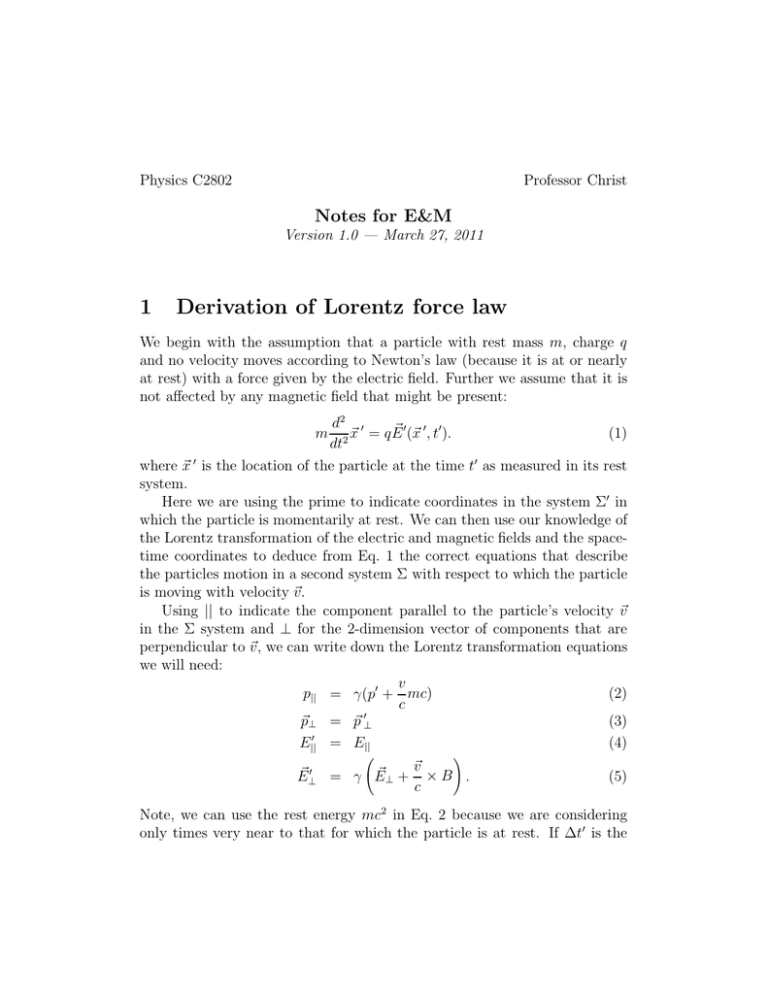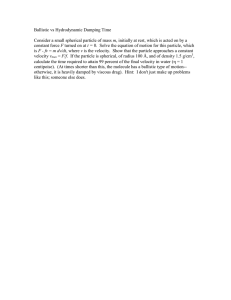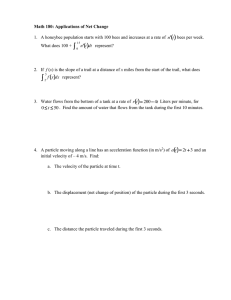1 Derivation of Lorentz force law
advertisement

Physics C2802 Professor Christ Notes for E&M Version 1.0 — March 27, 2011 1 Derivation of Lorentz force law We begin with the assumption that a particle with rest mass m, charge q and no velocity moves according to Newton’s law (because it is at or nearly at rest) with a force given by the electric field. Further we assume that it is not affected by any magnetic field that might be present: m d2 0 ~ 0(~x 0, t0). ~x = q E 2 dt (1) where ~x 0 is the location of the particle at the time t0 as measured in its rest system. Here we are using the prime to indicate coordinates in the system Σ0 in which the particle is momentarily at rest. We can then use our knowledge of the Lorentz transformation of the electric and magnetic fields and the spacetime coordinates to deduce from Eq. 1 the correct equations that describe the particles motion in a second system Σ with respect to which the particle is moving with velocity ~v. Using || to indicate the component parallel to the particle’s velocity ~v in the Σ system and ⊥ for the 2-dimension vector of components that are perpendicular to ~v , we can write down the Lorentz transformation equations we will need: v p|| = γ(p0 + mc) (2) c (3) ~p⊥ = ~p 0⊥ 0 (4) E|| = E|| ! ~ ⊥ + ~v × B . ~0 = γ E E ⊥ c (5) Note, we can use the rest energy mc2 in Eq. 2 because we are considering only times very near to that for which the particle is at rest. If ∆t0 is the difference in time from when the particle was at rest, its velocity will be of order ∆t0 which we will not neglect. However, its energy with differ from mc2 by an amount of order (∆t0)2 which we will be able to neglect. Now we consider two events located at the particle. One occurs when the particle is at rest in Σ0 . This first event is located by the four vector x. The second event occurs a very short time later and is located by x + ∆x. To first order in the elapsed time ∆t0 in the Σ0 system the particle, initially at rest, won’t have moved so ∆x0 = 0. We can then use the usual Lorentz formula (simple time dilation) to determine v ∆t = γ ∆t + 2 ∆x0 = γ∆t0. c 0 (6) Finally we can determine d~p/dt in the system Σ by separately examining the parallel and perpendicular components. First consider the parallel component: γ∆p0|| ∆p0|| dp|| ∆p|| ≈ = = = qE||0 = qE||. (7) dt ∆t γ∆t0 ∆t0 where the next to right-most equality comes from Eq. 1, Newton’s law assumed above to be valid for this slowly moving particle in Σ0 . An equation for the parallel component can be obtained in a similar way: ! ! ∆~p⊥ ∆~p0⊥ q ~0 q d~p⊥ ~ =q E ~ . ~ ⊥ + ~v × B ~ ⊥ + ~v × B ≈ = γ = = E E ⊥ dt ∆t γ∆t0 γ γ c c (8) Thus, both parallel and perpendicular components obey the same Lorentz force law in the Σ system: ! d~p ~ + ~v × B ~ . =q E dt c which is what we wanted to demonstrate in this note. (9)





